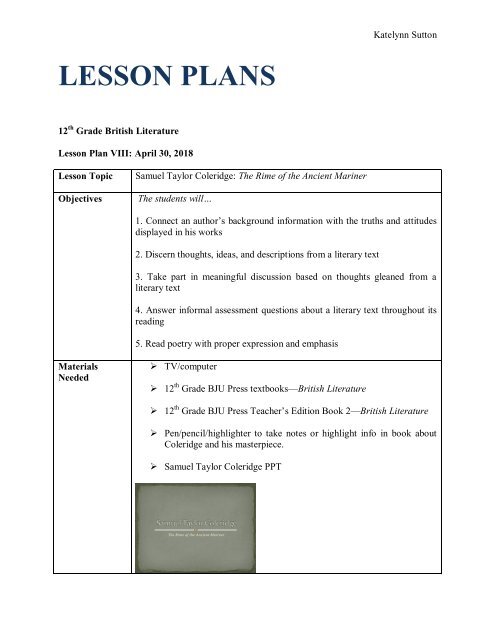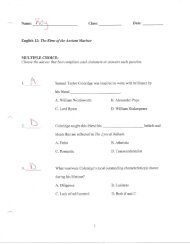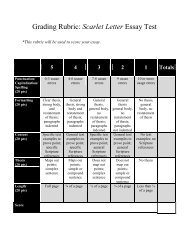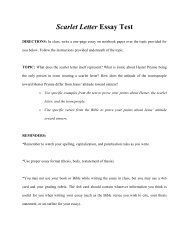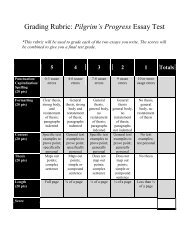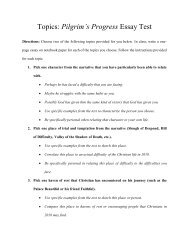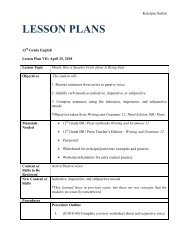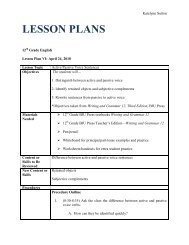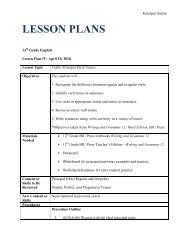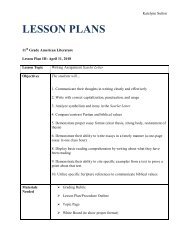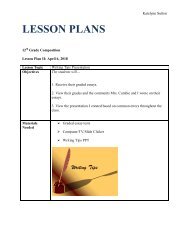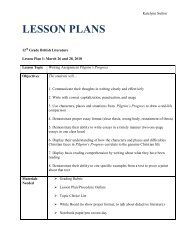24 The Rime of the Ancient Mariner Part 1- Lesson Plan PDF
You also want an ePaper? Increase the reach of your titles
YUMPU automatically turns print PDFs into web optimized ePapers that Google loves.
Katelynn Sutton<br />
LESSON PLANS<br />
12 th Grade British Literature<br />
<strong>Lesson</strong> <strong>Plan</strong> VIII: April 30, 2018<br />
<strong>Lesson</strong> Topic<br />
Objectives<br />
Samuel Taylor Coleridge: <strong>The</strong> <strong>Rime</strong> <strong>of</strong> <strong>the</strong> <strong>Ancient</strong> <strong>Mariner</strong><br />
<strong>The</strong> students will…<br />
1. Connect an author’s background information with <strong>the</strong> truths and attitudes<br />
displayed in his works<br />
2. Discern thoughts, ideas, and descriptions from a literary text<br />
3. Take part in meaningful discussion based on thoughts gleaned from a<br />
literary text<br />
4. Answer informal assessment questions about a literary text throughout its<br />
reading<br />
5. Read poetry with proper expression and emphasis<br />
Materials<br />
Needed<br />
‣ TV/computer<br />
‣ 12 th Grade BJU Press textbooks—British Literature<br />
‣ 12 th Grade BJU Press Teacher’s Edition Book 2—British Literature<br />
‣ Pen/pencil/highlighter to take notes or highlight info in book about<br />
Coleridge and his masterpiece.<br />
‣ Samuel Taylor Coleridge PPT<br />
<strong>The</strong> <strong>Rime</strong> <strong>of</strong> <strong>the</strong> <strong>Ancient</strong> <strong>Mariner</strong>
Katelynn Sutton<br />
• Youngest child, favored by his fa<strong>the</strong>r and alienated from bro<strong>the</strong>rs<br />
• Became a “dreamer”<br />
• Was known at Cambridge for his brilliance, reading, and<br />
idleness; never earned his degree<br />
• Formed unorthodox religious and political views<br />
• Founded <strong>the</strong> utopian community Pantisocracy in 1794 with<br />
Robert Sou<strong>the</strong>y <strong>of</strong> Oxford; married <strong>the</strong> sister <strong>of</strong> Sou<strong>the</strong>y’s fiancé<br />
• Eventually tired <strong>of</strong> <strong>the</strong> community, Sou<strong>the</strong>y, and even his wife<br />
• Suddenly sprang to life and brilliance when meeting William<br />
Wordsworth<br />
• <strong>The</strong>y composed <strong>the</strong> Lyrical Ballads toge<strong>the</strong>r to challenge<br />
conventional poetry and restore emotion and imagination in<br />
poetry<br />
• By 1802, Coleridge became addicted to opium and lost<br />
his faith in <strong>the</strong> transcendentalist beliefs he had taught<br />
to Wordsworth<br />
• Wrote “Dejection: An Ode,” mourning <strong>the</strong> loss <strong>of</strong> his<br />
creative powers<br />
• Returned from a health sojourn in an even worse<br />
condition<br />
• Attempted to write some prose pieces<br />
• Eventually broke from Wordsworth and moved to<br />
London, gaining some control over his addictive habit<br />
• Still could not finish a writing project<br />
• Utilizes ordinary language and lyrical verse form in<br />
ballad stanza<br />
• Story adheres closely to geographical fact– he<br />
describes an actual route used during <strong>the</strong> time period<br />
• Narrative also adheres to moral truth<br />
• Sin brings loneliness and separation<br />
• Adversity brings spiritual prosperity<br />
• Poem’s immediate end is pleasure while its ultimate<br />
end is truth<br />
• Entire story is seen through <strong>the</strong> eyes <strong>of</strong> <strong>the</strong> <strong>Mariner</strong><br />
Content or<br />
Skills to Be<br />
Reviewed<br />
New Content or<br />
Skills<br />
Transcendentalism and utopian societies<br />
Life <strong>of</strong> Samuel Taylor Coleridge and <strong>the</strong> background <strong>of</strong> his masterpiece <strong>The</strong><br />
<strong>Rime</strong> <strong>of</strong> <strong>the</strong> <strong>Ancient</strong> <strong>Mariner</strong> that opens up <strong>the</strong> Lyrical Ballads by Coleridge<br />
and Wordsworth<br />
Content, setting, and meaning <strong>of</strong> <strong>the</strong> poem itself<br />
Procedures<br />
Procedure Outline<br />
I. (8:45-8:55) Teach <strong>the</strong> life and background <strong>of</strong> Samuel Taylor<br />
Coleridge. Teach <strong>the</strong> background information about <strong>The</strong> <strong>Rime</strong> <strong>of</strong> <strong>the</strong><br />
<strong>Ancient</strong> <strong>Mariner</strong>.<br />
*I took <strong>the</strong> background info about Coleridge and <strong>the</strong> poem straight from <strong>the</strong>ir<br />
textbooks. I put those specific facts on <strong>the</strong> Power Point to highlight main
Katelynn Sutton<br />
points and keep us from having to read through all <strong>of</strong> <strong>the</strong> material in our<br />
books. <strong>The</strong> book’s section <strong>of</strong> background info is almost overwhelmingly<br />
long and detailed.<br />
A. Who was Samuel Taylor Coleridge? (use PPT to teach<br />
through his life)<br />
1. Youngest child, favored by his fa<strong>the</strong>r and alienated<br />
from bro<strong>the</strong>rs<br />
2. Became a “dreamer”<br />
3. Was known at Cambridge for his brilliance, reading,<br />
and idleness; never earned his degree<br />
4. Formed unorthodox religious and political views<br />
5. Founded <strong>the</strong> utopian community Pantisocracy in 1794<br />
with Robert Sou<strong>the</strong>y <strong>of</strong> Oxford; married <strong>the</strong> sister <strong>of</strong><br />
Sou<strong>the</strong>y’s fiancé<br />
6. Eventually tired <strong>of</strong> <strong>the</strong> community, Sou<strong>the</strong>y, and even<br />
his wife<br />
7. Suddenly sprang to life and brilliance when meeting<br />
William Wordsworth<br />
8. <strong>The</strong>y composed <strong>the</strong> Lyrical Ballads toge<strong>the</strong>r to<br />
challenge conventional poetry and restore emotion and<br />
imagination in poetry<br />
9. By 1802, Coleridge became addicted to opium and<br />
lost his faith in <strong>the</strong> transcendentalist beliefs he had<br />
taught to Wordsworth<br />
10. Wrote “Dejection: An Ode,” mourning <strong>the</strong> loss<br />
<strong>of</strong> his creative powers<br />
11. Returned from a health sojourn in an even<br />
worse condition<br />
12. Attempted to write some prose pieces<br />
13. Eventually broke from Wordsworth and moved<br />
to London, gaining some control over his addictive<br />
habit
Katelynn Sutton<br />
14. Still could not finish a writing project<br />
B. <strong>The</strong> <strong>Rime</strong> <strong>of</strong> <strong>the</strong> <strong>Ancient</strong> <strong>Mariner</strong><br />
1. Utilizes ordinary language and lyrical verse form in<br />
ballad stanza<br />
2. Story adheres closely to geographical fact– he<br />
describes an actual route used during <strong>the</strong> time period<br />
3. Narrative also adheres to moral truth<br />
4. Sin brings loneliness and separation<br />
5. Adversity brings spiritual prosperity<br />
6. Poem’s immediate end is pleasure while its ultimate<br />
end is truth<br />
7. Entire story is seen through <strong>the</strong> eyes <strong>of</strong> <strong>the</strong> <strong>Mariner</strong><br />
II.<br />
(8:55-9:20) Begin reading <strong>the</strong> poem <strong>The</strong> <strong>Rime</strong> <strong>of</strong> <strong>the</strong> <strong>Ancient</strong> <strong>Mariner</strong><br />
toge<strong>the</strong>r. Stop at <strong>Part</strong> IV (p. 542).<br />
A. Ask a few students to help me read.<br />
B. Stop to discuss important or interesting items from <strong>the</strong> text.<br />
(Ask students to explain what I want to emphasize before I<br />
tell <strong>the</strong>m what <strong>the</strong>y should have noticed—make <strong>the</strong>m think!)<br />
C. Make <strong>the</strong> narrative sound exciting and suspenseful to capture<br />
student interest.<br />
III.<br />
Ask informal assessment questions throughout to test student<br />
understanding.<br />
Key Questions<br />
(1) What did transcendentalists look to as “God”? (nature)<br />
(2) What is Coleridge’s most outstanding characteristic? (idleness—not living<br />
up to potential)<br />
(3) What does <strong>the</strong> spellbinding <strong>of</strong> <strong>the</strong> wedding guest to <strong>the</strong> <strong>Mariner</strong>’s tale<br />
represent? (reader unable to tear himself from a good work <strong>of</strong> literature even
Katelynn Sutton<br />
with o<strong>the</strong>r things pressing on him)<br />
(4) What protects <strong>the</strong> <strong>Mariner</strong>’s crew as <strong>the</strong>y travel? (<strong>the</strong> albatross)<br />
(5) What heinous crime does <strong>the</strong> <strong>Mariner</strong> commit—for no reason? (killing<br />
<strong>the</strong> albatross)<br />
(6) What hangs from <strong>the</strong> <strong>Mariner</strong>’s neck, weighing him down? (<strong>the</strong><br />
albatross—his sin and guilt)<br />
(7) What does his sin bring about? (loneliness, separation, and consequences<br />
for himself and those around him—<strong>the</strong>y all die while he is left alone in <strong>the</strong><br />
doldrums)<br />
Activities<br />
‣ Teaching <strong>of</strong> Coleridge’s life and background<br />
‣ Teaching <strong>of</strong> <strong>The</strong> <strong>Rime</strong> <strong>of</strong> <strong>the</strong> <strong>Ancient</strong> <strong>Mariner</strong>’s background<br />
‣ Reading <strong>of</strong> <strong>The</strong> <strong>Rime</strong> <strong>of</strong> <strong>the</strong> <strong>Ancient</strong> <strong>Mariner</strong><br />
‣ Discussion <strong>of</strong> <strong>the</strong> narrative as it is read aloud<br />
‣ Answering <strong>of</strong> informal assessment questions throughout <strong>the</strong> lesson<br />
Summary or Conclusion<br />
<strong>The</strong> <strong>Mariner</strong> is left in <strong>the</strong> doldrums alone as a result <strong>of</strong> his own wrongdoing.<br />
As he watches his crewmates fall in death one by one, <strong>the</strong>y look to him in<br />
accusation. He had seen and identified Death before she even arrived at <strong>the</strong>ir<br />
ship, knowing that he had summoned her. He realizes that his isolation and<br />
suffering are <strong>the</strong> result <strong>of</strong> his own sin.


